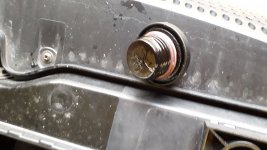The Panda Nut
Nutty about Pandas Infected by Panda virus and OPD
First one arrived and is now installed. 30 miles later the top of the engine is free of mayo. About a tablespoon and a half of water in the can after 35 miles.
Second catch can arrived damaged so yet another job to sort out on ebay purchases. The cars original hose has been rotated and reclipped and is a perfect fit. The fixing bolt fits in a pre-existing hole and the out hose to the can from the cam cover is a bit of caravan water pipe for now using the spare hose connector from the can as a reducer. It took about an hour with fiddling and fettling and was simple.
It will be interesting to see if the whole system dries out over the next few hundred miles and settles down, or if it just runs wet. Judging from the amount of water in the exhaust this is just a wet engine.
Next job replace the clamps on the flexi as both are nearly rusted away altogether.
Second catch can arrived damaged so yet another job to sort out on ebay purchases. The cars original hose has been rotated and reclipped and is a perfect fit. The fixing bolt fits in a pre-existing hole and the out hose to the can from the cam cover is a bit of caravan water pipe for now using the spare hose connector from the can as a reducer. It took about an hour with fiddling and fettling and was simple.
It will be interesting to see if the whole system dries out over the next few hundred miles and settles down, or if it just runs wet. Judging from the amount of water in the exhaust this is just a wet engine.
Next job replace the clamps on the flexi as both are nearly rusted away altogether.
Attachments
Last edited:





